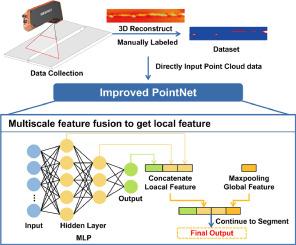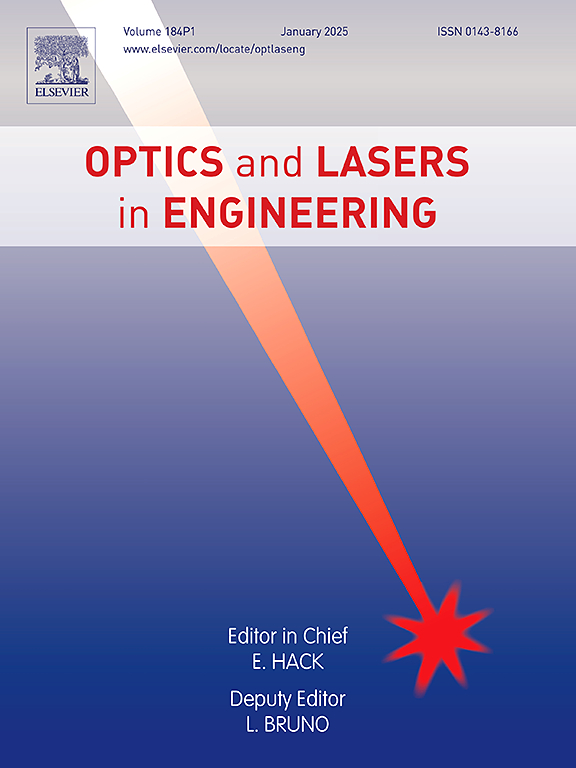改进的点网(PointNet)可在激光加工中在线检测缺陷的精度和效率之间进行权衡
IF 3.5
2区 工程技术
Q2 OPTICS
引用次数: 0
摘要
结构光视觉传感因其对激光束的抗干扰能力,被广泛应用于激光加工缺陷的在线检测。然而,现有算法无法高精度地提取焊接缺陷的特征。大规模点云数据的计算成本较高。如何平衡两者之间的关系是实现在线检测的主要挑战。为了提高精度并降低计算成本,本研究利用带有深度信息的点云数据,提出了一种点云分割方法。这是一种基于 PointNet 框架的新方法,已在激光焊接缺陷检测中得到验证。具体来说,该方法以 PointNet 框架为基础。它通过多尺度特征融合提取焊接缺陷的足够局部特征,将不同特征提取层的特征串联起来,从而学习到足够的特征来提高检测精度。实验在真实的焊缝数据集上进行。结果表明,该方法在焊缝测量和分类分割方面的性能极具竞争力,准确率达到 97.4%。与主干方法(PointNet)相比,所提出的方法将平均交集-过联合(mIoU)提高了 2.1%,表明其分割精度更高。此外,与 PointNet++ 相比,所提出的方法提高了检测速度。它可以达到每秒 60 帧,比 PointNet++ 快 7.5 倍,满足了在线监测的要求。总之,基于改进型 PointNet 的新检测方法具有更高的检测精度和更快的检测速度,其新颖的模型具有广泛的应用前景。本文章由计算机程序翻译,如有差异,请以英文原文为准。

Improved PointNet with accuracy and efficiency trade-off for online detection of defects in laser processing
Structural light vision sensing is widely applied in online detecting defects of laser processing due to their anti-interference ability for laser beams. However, the existing algorithms cannot extract the characteristics of weld defects with high precision. The computing cost of large-scale point cloud data is high. The balance between them is the main challenge to achieve online detection. To improve accuracy and reduce computation costs, this study uses point cloud data with depth information and proposes a point cloud segmentation method. It is a novelty method based on PointNet framework that has been verified for laser welding defect detection. Specifically, it used the PointNet framework as the backbone. It extracted enough local features of weld defects by multi-scale feature fusion, which concatenated features from different feature extraction layers to learn enough features to improve detection accuracy. The experiments were conducted on the real dataset of welds. The results showed its competitive performance in weld bead measurement and classification segmentation, and the accuracy of this method is 97.4 %. The proposed method improved mean intersection-over-union (mIoU) by 2.1 % compared with its backbone (PointNet), indicating a better segmentation accuracy. In addition, the proposed method improved detection speed compared with PointNet++. It can reach 60 frames per second, 7.5 times faster than PointNet++ and meet the online monitoring requirements. To conclude, the new detection method based on the improved PointNet with higher accuracy and faster speed of detection has a wide application prospect thanks to its novel model.
求助全文
通过发布文献求助,成功后即可免费获取论文全文。
去求助
来源期刊

Optics and Lasers in Engineering
工程技术-光学
CiteScore
8.90
自引率
8.70%
发文量
384
审稿时长
42 days
期刊介绍:
Optics and Lasers in Engineering aims at providing an international forum for the interchange of information on the development of optical techniques and laser technology in engineering. Emphasis is placed on contributions targeted at the practical use of methods and devices, the development and enhancement of solutions and new theoretical concepts for experimental methods.
Optics and Lasers in Engineering reflects the main areas in which optical methods are being used and developed for an engineering environment. Manuscripts should offer clear evidence of novelty and significance. Papers focusing on parameter optimization or computational issues are not suitable. Similarly, papers focussed on an application rather than the optical method fall outside the journal''s scope. The scope of the journal is defined to include the following:
-Optical Metrology-
Optical Methods for 3D visualization and virtual engineering-
Optical Techniques for Microsystems-
Imaging, Microscopy and Adaptive Optics-
Computational Imaging-
Laser methods in manufacturing-
Integrated optical and photonic sensors-
Optics and Photonics in Life Science-
Hyperspectral and spectroscopic methods-
Infrared and Terahertz techniques
 求助内容:
求助内容: 应助结果提醒方式:
应助结果提醒方式:


